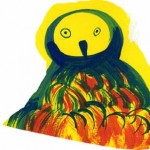News from Nowhere is probably the most ambitious art-project of Kassel’s dOCUMENTA 13. Presented in three forms: a film, an installation, a publication (plus a website), and taking the homonymous 1890’s book by William Morris as an inspiration, the work is depiction of a post-apocalyptic future where the human race has been nearly wiped out by a series of natural catastrophes and the survivors are forced to decipher the most basic philosophies upon which our world has relied.

The utopian dream and its unexpected side effects
By MOON KYUNGWON & JEON JOONHOThese apartments, once called the ‘strata of the future,’ are now regarded as the fruits of overproduction. At first, they presented the ‘mise-en-scene’ of a convivial family replete with fair hope and equal comfort, basically, a promise of an impartial posterity. Taken in 1972, this picture represents the monumental construction of the multi-housing complex in the Yong-dong district in the southeastern outskirts of Seoul. At the same time, the picture is also a printed proof of a developing country inching toward “progress”. In this light, the apartments also doubled as symbols to represent the economic development granted to the ‘Neo-Middle Class’ (a term coined under the Motherland Modernization Proposition). Such other ‘modernizations’ proliferated throughout the country with the motto: “Enjoyment at work, contentment in life.” Yet, those who desired to rise as this neo-bourgeois had to standardize their life and dreams to match the squared convention required to hitch a ride on the road to the utopia dream. And nowadays, these same generic matchbox homes have become the very culprit of social discord as their homogenization has produced negative, alienating, results. This has left us with a question: aren’t utopian dreams supposed to come in many different shapes and forms?
Text and image courtesy of the artists (with permission of the National Archives of Korea’s image copyright)
El fin del mundo, (2012), a dual-screened film directed by the Moon Kyungwon & Jeon Joonho, is a fictitious documentary which investigates the problematics of the present through subtle symbolism and metaphor.
A male and a female artist, working for a multinational corporation in futuristic settings, recollect and discuss about past traces of human inhabitation while trying to question and interpret the set of values and aesthetics, the irrationality and the social absurdities of the previous (art) world.
Another video of the installation (from the minute 2’18” onward)
Stills from the videos:






And the studio shooting:

Voice of Metanoia (2011-12), is an installation that, in dOCUMENTA 13, occupied a place adjacent to the screening room.
Presented in the form of an archive, it recreates the new products (clothes, tools) and lifestyle associated with the fictional multinational corporation that has become the new social system in the film. A group of artists and architects (MVRDV, Toyo Ito, Kuho, Takram, Kosuke Tsamura, Chung Sangmoon and Jeong Jaeseung) collaborated to this projects with boards, models etc.
Advisers and co-workers diagrams:


Finally, the book, entitled News from Nowhere, questions what the future holds for us today, in the present context of social, political, economical and climatic change. The book is divided in three parts, the first being a collection of contributions by many advisers, among whom stands Hans Ulrich Obrist, the second, containing material from the collaborating artists, and the third presenting excerpts and images from the film.
More than to provide future utopian/dystopian scenarios, the work as a whole aims to reflect at today’s social function and role of art and to envision the direction that contemporary art practices and society are taking.
A strong attention is given to the film’s music score, provided by experimental composer Toshi Ichiyanagi. Read the interview with Ichiyanagi in the NFN website.


Another interesting contribution, in the film, is for the characters’ vests and uniforms, for whom fashion designer KUHO has been consulted:


The website accompanies the three presentations with a platform of newsletters on the new installments of the project.
The following is the text from the newsletter #7, a debate around the subjects of Reality and Illusion:
Reality and Illusion
– The 2nd Conversation with Director Lee Chang-dong
2011.4, seoulJEON Joon-ho:
I’d like to talk to you about realism, as it seems to be an important element in your films. In terms of fabricated reality, how is realism in a film revealed and does it have any meaning? What do you think are the differences and similarities between realism in films and realism in the fine arts?
LEE Chang-dong:
Actually, the term realism isn’t all that clear. We generally think of it as showing what’s real, but the “real” in realism is closer to the reality of our lives as opposed to the “facts” we show it as. Originally, the concept of realism was based, at least somewhat, on an aspect of historicism; that is, looking at the reality of our lives from the perspective of the advancement of life and the belief that history progresses. In other words, such an attitude resists today’s reality in order to advance, and in doing so one inevitably has a critical look at realistic issues or becomes aware of the contradictions in reality.
However, this is where the term becomes a bit ambiguous. Although a lot of people talk about realism, they don’t share their ideas of how the medium of film can reflect or criticize reality in the field of films. In that vein, the realism that’s understood as something to describe and imitate reality in a very limited context is actually too limited, and may even become negative.
MOON:
In a sense, all the arts have aspects of realism to them. In the fine arts, painting has been regarded as a window on reality in a classical way. However, a realistic rhetoric is inadequate to explain various phenomena and the spirit of realism in the arts.
LEE:
Yes. As Aristotle said, art imitates nature. The questions, however, becomes what kind of imitation this will take. According to Aristotle, imitating the dead body of a soldier in war can give us as much aesthetic pleasure as imitating a beautiful flower. Yet there’s a clear difference in the aim and attitude of imitating two things as different as a beautiful flower and a dead soldier’s body. This difference can’t be explained simply with realistic rhetoric. In films today, the term “neorealism” is more common than realism. This movement took root in cinema in Italy after World War II, and was, for films, something that clearly showed what realism was and accepting and criticizing reality in films for the first time in history. In a way, neorealism seems to be limited to a certain period in a certain country, as its name indicates. To be honest, I feel a little uncomfortable about my attitude with moviemaking when it’s categorized as “realism.” The “-ism” suffix makes people think of something in a prejudicial way when the truth is that a film’s reality is not something we can categorize, per se, as it’s more important than that.
MOON:
An artist’s attitude about reality is important in every art form. Viewing realism as something prejudicial is a myopic approach, but when we relate realism to an attitude, my question about realism in films becomes somewhat vague.
LEE:
You may think that, but I think the matter of realism in films is not quite as simple. I mean, there’s no other medium that can imitate reality as well as film. Unless it’s animation, everything you shoot using a camera is an aspect of reality. However, this reality as a subject is usually ambiguous. The landscape outside our window can be altered and made unrealistic, but at the same time the exact same landscape can be portrayed either realistically or unrealistically with the camera. Film is a medium that can best represent reality and at the same time it can be further from reality than any other medium; it makes you look at reality and forget about it at the same time. Today, it seems as if forgetting about reality is a movie’s prime objective. Audiences go to theaters to escape reality. They experience a stimulus and a danger in the pseudo reality of the movie, but they can take it all in with a relaxed mentality because they know it’s not a true reality. The moment they believe it could actually be someone’s reality, it begins to feel uncomfortable. In order for the film to become not just a simple source of entertainment but an escape from reality and a means of communication that leads us to true introspection about our own life, the creation of films needs to become a struggle against that which is undesirable in life. These days, most films compete with each other to provide audiences with a certain element of fantasy and stimulus to help us escape from reality, so it’s not enough to simply say, “Oh, this is a realistic film” when we see one that pursues a true sense of mimesis or which lets audiences understand and reflect on reality.
MOON:
In the fine arts, realism means pursuing beauty based on self-identification and an understanding that focusing on content, rather than style, delivers meaning in the relationship between external expressions and reality. In what way do you want the reality you capture through your film to be delivered to audiences? Is there any critical message you want to deliver to your audience?
LEE:
I’m asked this same question a lot. The truth is, I don’t believe in messages. I think art or the act of creation is not about providing answers but about asking questions. Answers should be arrived at by the individual. Providing an answer even believing that there is an answer is not an artistic or creative endeavor. I think it’s somewhat doubtful. In fact, the most entertaining films have the easiest “messages” justice wins out over everything, for example. But that’s nothing but meaningless deception when it comes to being introspective about life. Audiences feel uncomfortable about films that ask questions without giving an answer, but I don’t want to stop asking questions in my own movies.
MOON:
What questions, for example?
LEE:
I guess the process of how to ask a question is more important than what to ask, as this allows artistic creativity or newness to be employed. Just as there are fake messages, there are fake questions that are meaningless even if they pretend to be questions. Quite simply, they’re empty, worthless questions. In order for questions to become meaningful and powerful, you have to look at how to ask them. For example, my film Oasis asks questions about communication. It’s not only communication between physically challenged people and the rest of society, but also communication between me and many other things what’s different from me, what I instinctively hate, and what is ugly. These questions are about accepting and communicating with those things that are different from me, and also include how much the medium of film can communicate with an audience. Movies are accepted by an audience through experience. In Oasis, the lead actress, who has a severe case of cerebral palsy, asks viewers if they can love her and whether they can truly communicate with her. This way of portraying the lead character allows the movie to communicate with audiences directly. In real life, we may pretend not to have seen someone with a problem like cerebral palsy and avoid them, but audiences can’t help watching her on the screen. I thought it was a way of posing a question that is only made possible through films.
JEON:
In the fine arts, Gustave Courbet’s words imply a great deal about realism. When asked to paint angels, he said “I’ve never seen angels. Show me an angel and I’ll paint one.” The context is a bit different, but Courbet’s words have something to do with what you just said. As you make audiences face something they may not have wanted to deal with, Courbet didn’t avoid the reality he faced, revealing it within his limited canvas when others were looking for a church and angels. For you, what is it you’d like to show people or have them face?
LEE:
Actually, films don’t portray what is identifiable by the naked eye or what you can hear through mediums such as music. Showing something in a film is not just about presenting something for a person to look at; it’s also capturing a person’s desires, their behavior and actions, and a part of life it extends all the way to what the camera itself can’t capture. As a result, it’s not so much a matter of “what to show” as it is “what you make audiences look at.” Movie frames are an example of this, as they’re not that different from the concept of frames in the fine arts of the modern era, which separates the world both inside and outside the frame. A frame sees the world inside the frame as perfect and disconnects the world from the outside. Consequently, it’s separated from a viewer’s reality. However, if the camera isn’t fixed but constantly moving, like through a handheld camera, it can serve to rid the border of the frame. Put another way, the distinction between film and reality disappears. In this way, directors can allow people to see more than what they’ve been able to capture on the screen. There are many other examples of this, from detailed methods like whether you use a telephoto lens or a wide-angle lens to a shot taken from far away or done close-up to views and attitudes toward reality and life. I think the same thing can be applied to other media, including the fine arts.
MOON:
Courbet’s realism was not simply painting the realistic landscapes he wanted to paint; his works contained a painter’s subjective ideas, a distinct view of the “real” landscapes of his time. But since Courbet’s time, realism has changed or melded with other elements, giving today’s realism, including hyperrealism and photo realism, different aspects to it from the realism of his age. We use the term when we explain a concrete phenomenon, like “This expression is realistic” or “I feel reality.” It’s less often used to explain essential concepts, though. The attitude of realism in the fine arts is not a matter of style, but is meaningful in that the attitude produces possibilities of more serious reflection and communication in people’s lives, while also responding to the issues of our times.
JEON:
Recently, in Korean art circles, hyperrealism has been very influential. The sale of hyperrealist paintings has increased, as has its popularity. Yet terms like “hyperrealism” and “photo realism” can’t point out reality or create a sense of content all on their own they exist as methodologies in a very limited context. I even wonder whether such formal terms can be included in the category of realism. Realism, in a limited sense, is something that should be overcome, even in the fine arts. How, for instance, can the act of perfectly painting objects as opposed to statements about issues in reality based on the artist’s experience or the desire of one’s heart communicate with society? And what role can it play? I’m not very positive about that. Isn’t a warm and fuzzy view of the reality of the land that the artist is standing on more necessary than any singular technical skill? The act of observing and portraying reality is related to a reflection on the future, and whether it’s heading towards a utopia or a dystopia.
LEE:
A dystopia may be related to the destiny of art. For example, I started the film Poetry with the question “What’s the meaning of writing poetry in an age when poetry is dying?” And for me, the question was the same as “What is the act of making films in an age when films are dying?” When I relayed these thoughts to foreign reporters, they asked me if I really felt that films are dying.
MOON/JEON:
What do you believe?
LEE:
I feel that the medium of film is dying and that’s no exaggeration. Movies like Transformers and Avatar achieved enormous success worldwide, but movies which reflect on our lives and ask us the tough questions as viewers are gradually dying out. As the movie industry continues to change, people can now watch movies on the Internet easier than going to a theater. Ironically enough, those same movies that challenge us as viewers are hard to find even on the Internet. Alternatively, multiplex theaters are busy playing movies that are an escape for people, with big-budget films dominating the screens. With the advent of digital technology, filmmaking became popularized and democratized to the point where anybody can make a movie. And still, some movies don’t reach a wide audience. Today, film production has become a huge industry through infinite copying and mass distribution, unlike when the Lumiere brothers showed their first film at the Grand Cafe in Pairs 110 years ago. Huge-scale investments, marketing, and distribution now dominate the movie industry. Quite simply, films are not “communicated” anymore; they’re distributed and consumed. Films, in their true sense as mutual communication are gradually dying out.
JEON:
You mentioned mass distribution and that makes me think of K-pop. Newspapers, radio stations and TV channels make a big deal of these Korean idol groups, almost as if they’re trying to promote Korean culture internationally. They say that decades ago, when Cliff Richard came to Korea for concerts, female fans were so enamored that they’d throw their underwear on stage, but nowadays it seems to be the opposite. It’s really hard for me to see these huge entertainment agencies mislead mass culture in collusion with one another, while the public just stands back and accepts it and believes this promises a better future. It’s awful that such a parasitic phenomenon, agencies producing “art” in their forceful way by throwing money at people and taking advantage of young people’s dreams, is considered an achievement that is furthered by effective marketing and the ability to increase the popularity of K-pop. I wonder how realism is related to this phenomenon, or how realism can withstand the fact that, as you said, films are dying.
LEE:
Hmm. What’s certain is that this is not limited to films but culture in general. I think it’s more related to how we as humans communicate and the ways in which we accept the aesthetic, isn’t it? For example, there are questions like how to look at beauty. Would the twilight still be beautiful after the end of the world? What would the world be like after the arts die?
MOON:
What would it be like if this future you speak of comes earlier than we expect? If not the end of the planet, perhaps a dystopian world? In an age when the environment, nation states, religion, science, society, values, and films are all disappearing, what should the arts and culture do?
LEE:
Fight on. If a dystopia is in our midst, fighting is the only thing that the arts can do. Resist reality and prove that we have the ability to do so.LEE Changdong
Born in 1954, LEE was a well-known writer during the 1980s, and in 1997 he made his debut as a film director with Chorok-Mulkogi(Green Fish). And two years later, he was awarded the Jury’s Award at the Karlovy Vary International Film Festival(KVIFF) with his second film Bakhasatang(Mint Candy). Moreover, his third film, Oasis, was awarded the Special Director’s Award at the Venice International Film Festival(VIFF), thus receiving international attention with just three films. In 2003 he was appointed and served as the Minister of Culture in Korea. In addition, his most recent film in 2010, Shi(Poetry), was awarded the Prix du scenario(Best Screenplay) at the 63rd Cannes Film Festival(CFF).





I would like to get the book please inform us how we can purchase the book thank you
You can find the contacts for buying the book at this address: http://newsfromnowhere.kr/index.php?/medium/book/